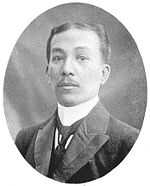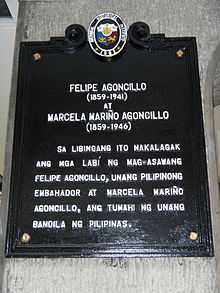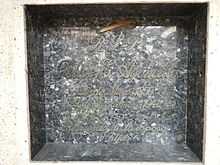Felipe Agoncillo
| Felipe Agoncillo | |
|---|---|
 A portrait of Felipe Agoncillo. | |
| Born |
Felipe Agoncillo May 26, 1859 Taal, Batangas |
| Died |
September 29, 1941 (aged 82) Manila |
| Residence | Taal Batangas and Malate Manila |
| Nationality | Filipino |
| Other names | Don Felipe, Lolo Pipoy |
| Education | Bachelor of Arts |
| Known for | His legacy as the first Filipino diplomat. |
| Spouse(s) | Marcela Agoncillo |
| Children | Lorenza, Gregoria, Eugenia, Marcela, Adela and Maria |
| Parents | Ramon Agoncillo and Gregoria Encarnacion |
Felipe Agoncillo (May 26, 1859 – September 29, 1941) was the Filipino lawyer representative to the negotiations in Paris that led to the Treaty of Paris (1898), ending the Spanish–American War and achieving him the title of "outstanding first Filipino diplomat."[1]
As a family friend and adviser of General Emilio Aguinaldo[2] and General Antonio Luna[3] during the critical times of the revolution, Agoncillo has been active in participating during that era especially when he presided over the Hong Kong Junta—a group of Filipino exiles who met to plan for future steps in achieving independence.[4] His greatest contribution of the Philippine history was when he was assigned to negotiate foreign countries to secure the independence of the country considered as the most important assignment given by a General.[5]
Outstanding student
Agoncillo was born on May 26, 1859 in Taal, Batangas to Ramon Agoncillo and Gregoria Encarnacion.
At an early age, his parents already noticed his brilliant mind. He enrolled at the Ateneo Municipal de Manila where he was a consistent honor high school student and later transferred to the Universidad de Santo Tomás where he obtained his law degree in 1879 with an excellent grade. He was granted a Licentiate in Jurisprudence with the highest honors.
He returned to Taal to manage his family's properties after a year studying in Manila because his parents had both died.

Marriage
Agoncillo was already a judge and at the age of 30 when he was married to Marcela Mariño, a daughter of a reputed family in the same town. Six daughters were born to them: Lorenza (Enchang), Gregoria (Goring), Eugenia (Nene), Marcela (Celing)—named after her mother because they thought she will be their last child, Adela, who died at the age of three and the youngest Maria (Maring), who was their last child to survive and died on July 6, 1995.
Charity
While in Taal, Agoncillo continued his legal services and gave charity to poor and oppressed Filipinos. He was so generous that he posted an inscription outside his office: "Free legal services to the poor anytime."[6]
Having heard by the parish priest of his activities and for preaching patriotic ideas, he was accused as anti patriotic, anti religious and was described as filibustero or subversive. He was later recommended to the governor-general for deportation.
Exile to Hong Kong
Forewarned by the plans of the governor-general, he sailed directly to Yokohama, Japan but briefly stayed and went to Hong Kong where he joined other Filipino exiles who found asylum when the revolution broke out in 1896. They temporarily sojourned at Morrison Hill Road in Wanchai and later became a refuge for exiled Filipino patriots.
When the signing of the Pact of Biak-na-Bato concluded, Gen. Aguinaldo joined to them. They initiated meetings in the Agoncillo residence on the months of April and March 1898 and Gen. Luna was one in the attendance.[7]
Diplomacy
After the signing of the truce, Agoncillo spearheaded the Central Revolutionary Committee and organized the propaganda office for General Aguinaldo's revolutionary government.
The Philippine Revolutionary Government commissioned Agoncillo as Minister Plenipotentiary to negotiate treaties with foreign governments. Agoncillo and Jose "Sixto" Lopez was sent to Washington, D.C., United States[8] to lobby foreign entities that Filipinos are well civilized people and capable of maintaining stable government[5] and to secure recognition of Philippine independence but US President William McKinley did not receive them. To gather sympathy to the Philippine cause, they addressed the American Episcopalian bishops.
After being ignored by the US president, Agoncillo proceeded to Paris, France to present the Philippine cause at the peace conference convened between Spain and the US, where a meeting was to be held to discuss Cuba and the Philippines. Agoncillo tried to submit a memorandum but again failed. The people behind the meeting did not want to have any official dealings with him.[5] On December 10, 1898, the treaty was successfully signed.
Subsequently, Agoncillo's diplomatic activity incurred sum of money that he had used up all his savings going from one country to another presenting the case of the Philippines that he had even sacrificed his wife's jewelry.
Agoncillo's protest
Two days after the signing of the Treaty of Paris, Agoncillo returned to the United States and endeavored to block ratification of the treaty by the US. Although this was signed by the commissioners, it was not yet approved by the Senate of the United States. He filed a State memorandum to express that Filipinos must be recognized by the United States.[9] He presented a formal protest which was called Memorial to the Senate to the president and delegates of the Spanish-American Commission saying:
If the Spaniards have not been able to transfer to the Americans the rights which they did not possess; if the latter have not militarily conquered positions in the Philippines; if the occupation of Manila was a resultant fact, prepared by the Filipinos; if the international officials and representatives of the Republic of the United States of America offered to recognize the independence and sovereignty of the Philippines, solicited and accepted their alliance, how can they now constitute themselves as arbiters of the control, administration and future government of the Philippine Islands?
If the Treaty of Paris there had simply been declared the withdrawal and abandonment by the Spaniards of their domination --if they had such --over Filipino territory, if America, on accepting peace, had signed the Treaty, without prejudice to the rights of the Philippines, and with a view to coming to a subsequent settlement with the existing Filipino National Government, thus recognizing the sovereignty of the latter, their alliance and the carrying out of their promises of honor to the said Filipinos, no protest against their action would have been made. But in view of the terms of the Article III of the Protocol, the attitude of the American Commissioners, and the imperative necessity of safeguarding the national rights of my country, I take this protest, for the before-mentioned reasons but with the proper legal reservations, against the action taken and the resolutions passed by the Peace Commissioners at Paris and in the Treaty signed by them.[10]
Agoncillo's conclusion about the treaty was that it was not binding on the Philippine government.[6] In the memorandum, he clearly stated the reasons why Spain had no right to transfer the Philippines to the United States and that when the treaty was signed, Spain no longer held the Filipinos.
At that time, many Americans were also against the treaty, so they established the Anti-Imperialist League which opposed making the Philippines a colony of the United States. Afterwards, on February 4, 1899, the Philippine–American War began; this turned on approval of the treaty of Paris.
Post Philippine–American War
On August 29, 1900, he met with Gustave Moynier, an original member of the Committee of Five and ICRC President. Agoncillo sought recognition of the Filipino Red Cross Society as well as the application of the First Geneva Convention during the Philippine–American War.[11]
Return to Manila
When hostilities ended between Filipinos and Americans, he returned to Hong Kong and rejoined the exiled junta. Later, on July 15, 1901, after American rule was firmly established in Manila,[7] he went back to the Philippines as a poor man and lived in his house in Malate, Manila together with his family.
Continuing service
While in Manila, he resumed his law practice and other business. He took the bar exam in 1905 and passed with a perfect score of 100 percent, an achievement which has remained unmatched until today. His examination papers have been preserved in the Filipiniana section of the Philippine Library and Museum.
In 1907, he was elected as the Batangas representative and represented that town, among others, in the Philippine Assembly.[12] He was once a defense of El Renacimiento whose editors were charged with libel by Dean C. Worcester. De Agoncillo was appointed as Secretary of Interior in 1923 during the administration of Governor General Leonard Wood and fought for the Filipinazation of the government service.[6]
Death


Agoncillo died on September 29, 1941 in Manila Doctor's Hospital, Manila.
Legacy
The Felipe Agoncillo Ancestral House is located at Taal, Batangas.
Quotes
The following quotes have been attributed to Agoncillo:[13]
- Kailangan ang katapatan upang magkaunawaan. (Truth is needed to attain understanding.)
- Kailangan ng mga sawimpalad ang pagkalinga ng mga higit na mapalad. (The less fortunate need care from the more fortunate.)
- Kayamanan, oras, at kahit na buhay ay maiaalay ng taong nagmamahal sa bayan. (A person who loves his or her country can offer to it wealth, time or even life itself.
References
- ↑ Ty, L.O. (1979). Examiner. L.O. Ty. Retrieved 2007-11-29.
- ↑ Agoncillo, Teodoro A. (1974). Introduction to Filipino History. Quezon City, Philippines: GAROTECH Publishing. p. 139. ISBN 971-10-2409-8.
- ↑ Agoncillo. p. 164. Missing or empty
|title=(help) - ↑ Agoncillo. p. 141. Missing or empty
|title=(help) - ↑ 5.0 5.1 5.2 Agoncillo. p. 155. Missing or empty
|title=(help) - ↑ 6.0 6.1 6.2 Quirino, Carlos (1995). WHO'S WHO: In Philippine History. Metro Manila, Philippines: Tahanan pacific Inc. p. 21. ISBN 971-630-046-8.
- ↑ 7.0 7.1 de Viana, Augusto V. "A Haven for Patriots". National Historical Institute. Retrieved 2007-12-13.
- ↑ "AGONCILLO IS PERSISTENT." (PDF). The New York Times Company. (1899-01-16). Retrieved 2007-11-16.
- ↑ "FILIPINOS AT WASHINGTON.; The Two Delegates from the Insurgents Arrive at the Capital to See President McKinley." (PDF). The New York Times Company. (1898-09-28). Retrieved 2007-11-16.
- ↑ "Felipe Agoncillo's Protest on the Injustice of the Treaty of Paris". MSC Communications Technologies, Inc. 1999-06-11. Retrieved 2007-12-13.
- ↑ "A CHRONOLOGY OF SIGNIFICANT EVENTS". The Philippine National Red Cross. Archived from the original on 2007-10-23. Retrieved 2007-12-13.
- ↑ "First Philippine Assembly" (PDF). National Historical Institute. Nhi.gov.ph. 2007-11-16.
- ↑ "FELIPE E. AGONCILLO". MSC Communications Technologies, Inc. Retrieved 2007-12-13.
External links
| Wikimedia Commons has media related to Felipe Agoncillo. |
See also
|